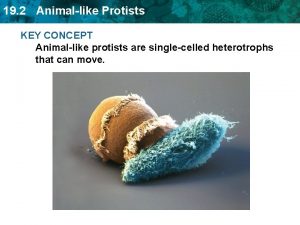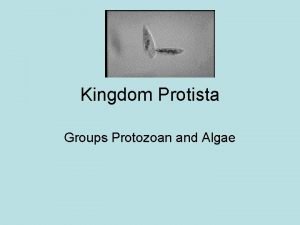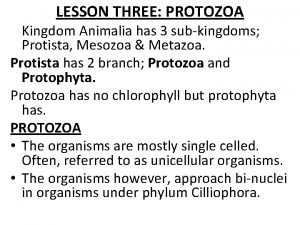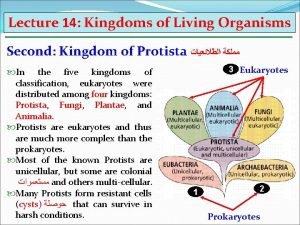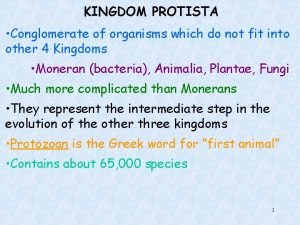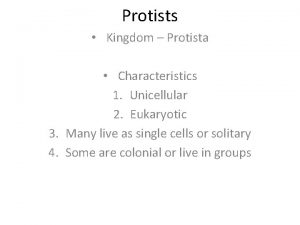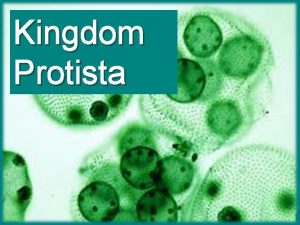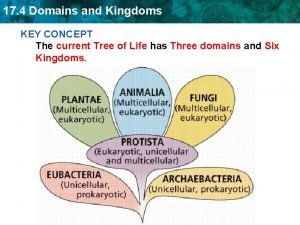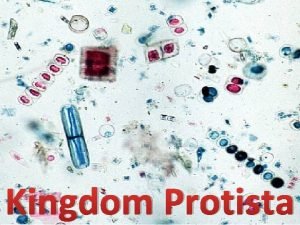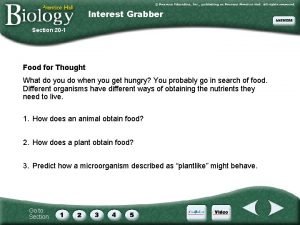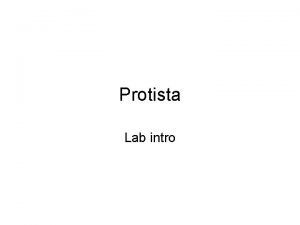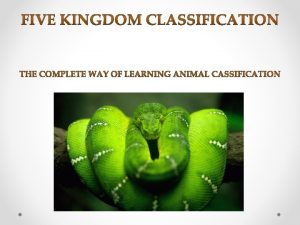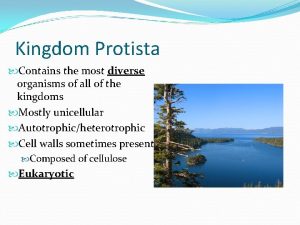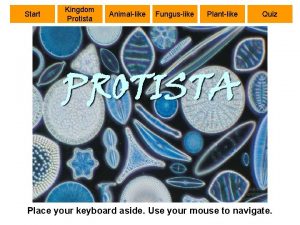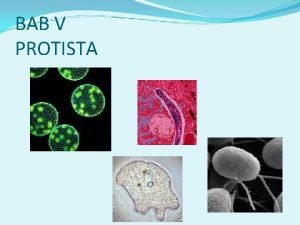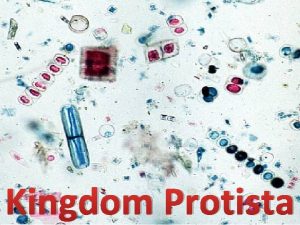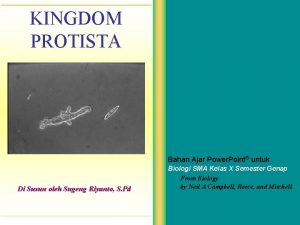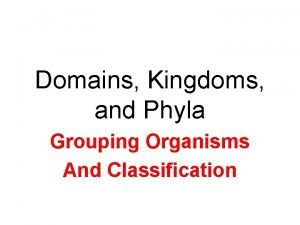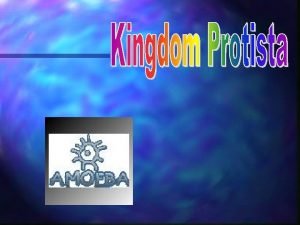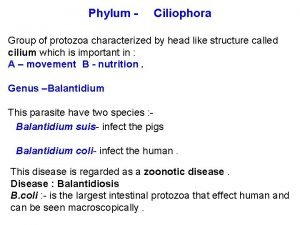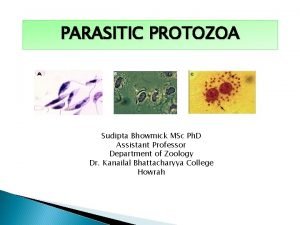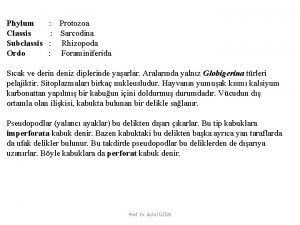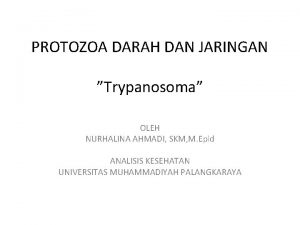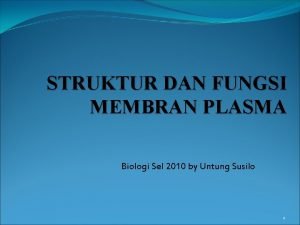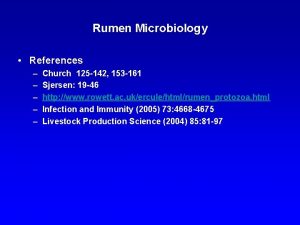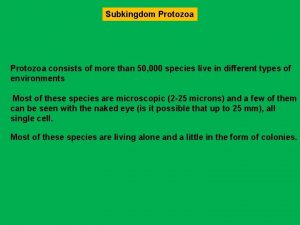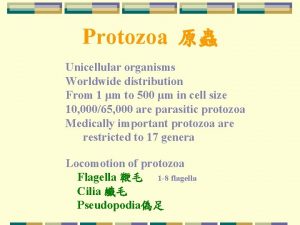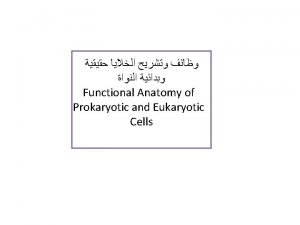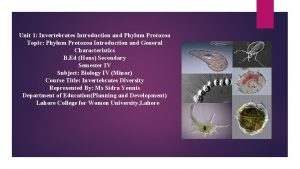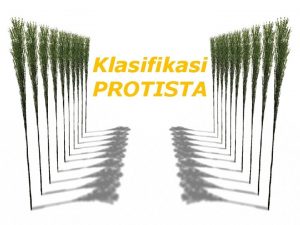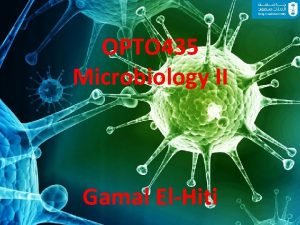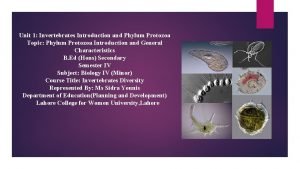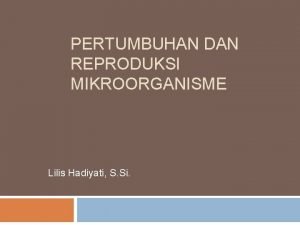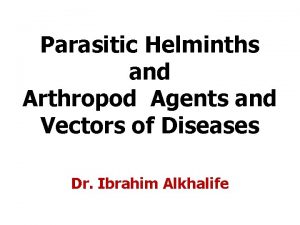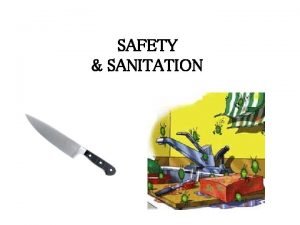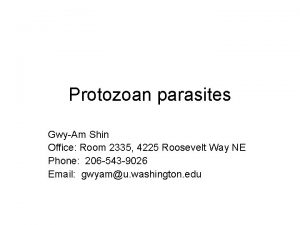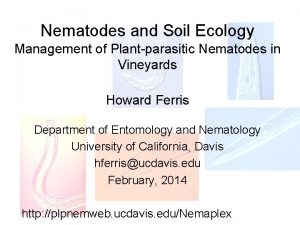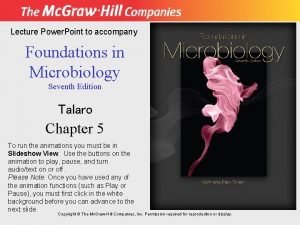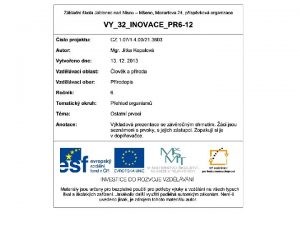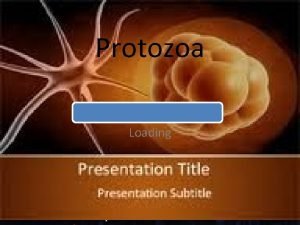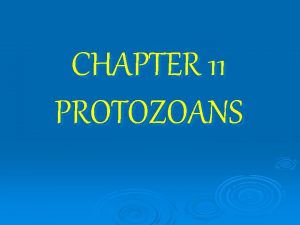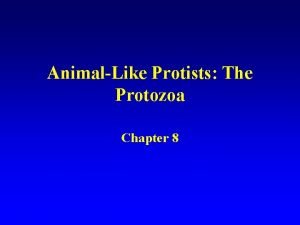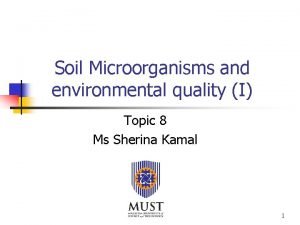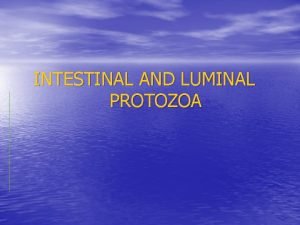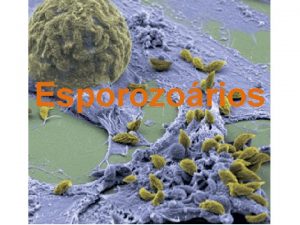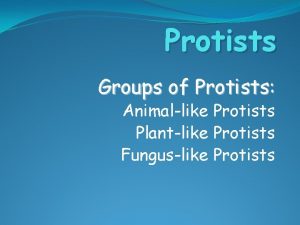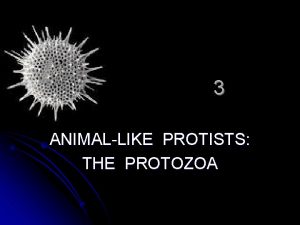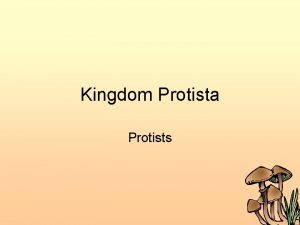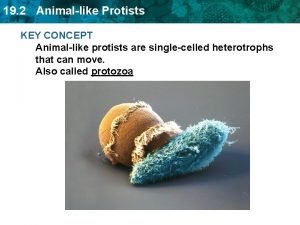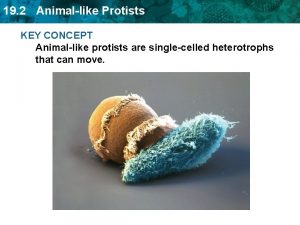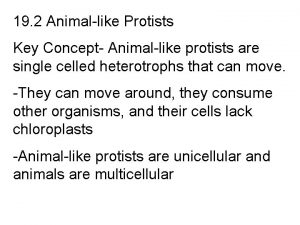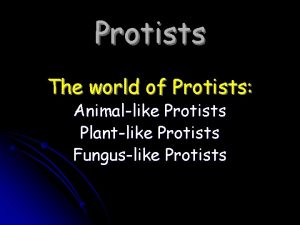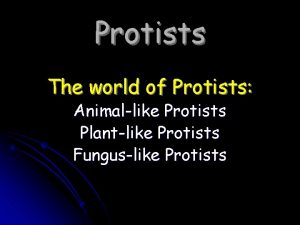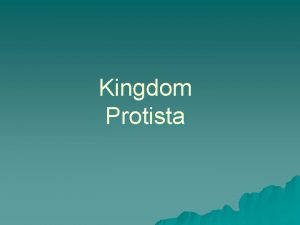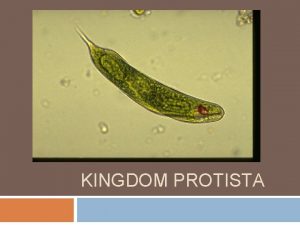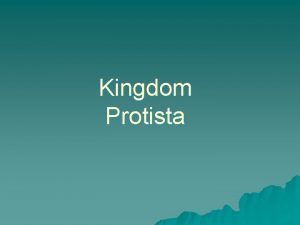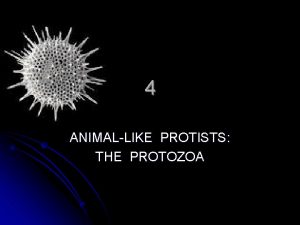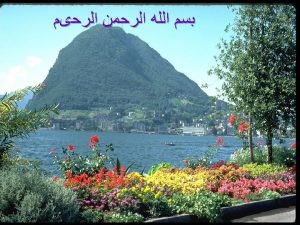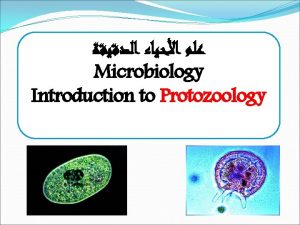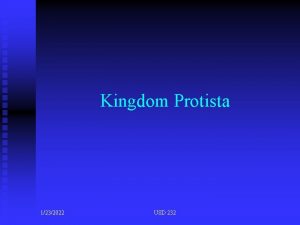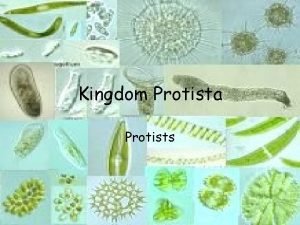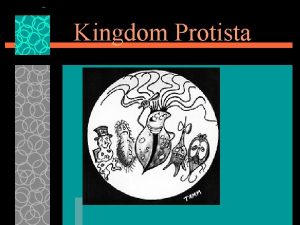Kingdom Protista Kingdom Protista Protozoa The AnimalLike Protists
































































- Slides: 64

Kingdom Protista

Kingdom Protista Protozoa The Animal-Like Protists

Sec 26. 1 Overview of Protozoa

Diatoms Euglenoids Red Algae Golden Algae Green Algae Plant like Brown Algae Dinoflagellates Plasmodial Slime Mold Ciliophorans Zooflagellates Water Mold Protist Ancestor Animal like Sarcodinians Cellular Slime Mold Sporozoans

Diatoms Red Algae Golden Algae Green Algae Euglenoids Plant like Brown Algae Dinoflagellates Plasmodial Slime Mold Ciliophorans Zooflagellates Water Mold Protist Ancestor Animal like Cellular Slime Mold Sarcodinians Sporozoans

Characteristics of Protozoa Single-celled microscopic eukaryotic organisms that are noted for their ability to move u Sometimes referred to as animal-like protists u Live in many environments u Most are heterotrophic, obtaining their nutrients by ingesting small molecules into food vacuoles u

Characteristics - continued Most live in aquatic environments u Many species make up zooplankton u Parasitic protists have complex life cycles that are very harmful to their host. u

Reproduction All protozoa can reproduce asexually, usually by binary fission u Some species reproduce by multiple fission u Some species are able to reproduce sexually through conjugation u

Classification Protozoa are classified based on the way they move u There are four phyla of protozoans u Phylum Common Name Locomotion Sarcodina Sarcodines Pseudopodia Ciliophora Ciliates Cilia Zoomastigina Zooflagellates Flagella Sporozoans None in adults

Adaptations Many free-living species have a localized region of pigment, a substance that produces a characteristic color in an organism, called an eyespot or stigma. u Eyespots detect changes in the quantity and quality of light. u

Adaptations - continued Certain species also sense physical and chemical changes or obstacles in their environment u Most are separated from their environment by their cell membrane. u

Adaptations - continued u u u Some species have the ability to survive in extreme conditions due to their ability to form cysts A cyst is a dormant form characterized by a hardened external covering in which metabolic activity has ceased. Many form cysts in response to changes in the environment such a drought, decrease in oxygen supplies, etc.

Evolution of Eukaryotes

Complete RG & Rev 26. 1

Sec 26. 2 – Protozoan Diversity

Phylum Sarcodina Sarcodines include hundreds of species of Amoebas, which inhabit freshwater, salt water and soil. u Sarcodines move by pseudopods, lobe extensions of cytoplasm, known as amoeboid movement. u

Phylum Sarcodina - Movement Pseudopodia forms when endoplasm pushes the ectoplasm forward to create an arm like extension u Then the cytoplasm streams into the pseudopodia and pulls the organism u

Amoeba proteus Pseudopodium: part of the Amoeba used for locomotion. Ectoplasm: vitreous superficial layer of an Amoeba. Endoplasm: central part of an Amoeba. Cell membrane: membrane covering an Amoeba. Contractile vacuole: cavity of the amoeba that is able to contract. Food vacuole: cavity of the Amoeba responsible for digestion. Nucleus: central organelle for an Amoeba. Digestive vacuole: cavity of the Amoeba responsible for digestion.

Phylum Sarcodina - Feeding u u Sarcodines also use pseudopodia for feeding. When a sarcodine feeds, it surrounds the food with its pseudopodia. A portion of the cell membrane then pinches together and surround the food to form a food vacuole, in a process called endocytosis. Undigested food leaves the cell in a reverse process called exocytosis.

Phylum Sarcodina - Features u u u Most fresh water sarcodines have contractile vacuoles When conditions are unfavorable ameobas survive by becoming cysts Some sarcodinians have hard shell or tests of calcium carbonate or silica which has accumulated over the years to form Earth’s limestone beds.

Sarcodinians and Humans Amoebas as cysts can spread by water, in food or on dirty dishes to spread Amoebic dysentry, which secretes enzymes that attack our intestinal lining u This disease can cause deep ulcers and other organ complications. u

Phylum Ciliophora Members of this phylum swim by means of cilia u The cilia is used for movement by beating like oars to propel the protist u Most ciliates live in freshwater. u

Paramecium caudata u u u Pellicle – protective covering over the cell that regulates material in and out of the cell Oral Groove, mouth pore, gullet and food vacuoles are where food travels to be digested Anal pore – where undigested material is removed from the cell Contractile vacuoles – remove excess water Macronucleus – controls cell activities Micronucleus – used in conjugation

Phylum Ciliophora - Conjugation u u u In conjugation, two opposite mating strains exchange genetic material Although genetic material is exchanged during conjugation, no new cells are produced. Following conjugation, each paramecium divides producing four genetically identical paramecia

Phylum Zoomastigina The members of this phylum are characterized by the presence of one or more flagella u Some are free-living freshwater or marine organism u

Phylum Zoomastigina Many live inside other organisms in symbiotic relationships u The symbiotic relationships can be u – Mutualistic – both organisms benefit – Parasitic – causes harm to the host

Phylum Sporozoa u u u Members of this phylum have adult forms with NO means of movement Most sporozoans are sporeforming parasitic protozoans The name sporozoan comes from the fact that when they are immature, they are surrounded by thick, sporelike walls

Phylum Sporozoa Adult sporozoans have no structures for movement. u Immature sporozoans called sporozoites, can be transmitted through fluids from one host to another. u

Life Cycle of Plasmodium

Complete RG & Rev 26. 2 Due tomorrow

Kingdom Protista Algae The Plant-like Protists

Sec 27 -1 Overview of Algae

Algae Characteristics Algae are a diverse group of protists, they range in size from microscopic unicellular to large multicellular seaweeds. u Algae are autotrophic and perform plant-like photosynthesis because they have chlorophyll u

Algae Characteristics continued u u Algae are different from plants because the lack tissue differentiation and have no true roots, stems or leaves The reproductive structures form gametes in singlecelled gametangia, gamete chambers where as plants have a multicellular chamber.

Algae Characteristics continued u All algae – Are aquatic, live in freshwater or marine environments – Have flagella at some point in their life cycle – Have pyrenoids, which are special organelles that synthesize and store starch

Algae Structure u u The body portion of an alga is called a thallus The thallus comes in four different body types a) b) c) d) Unicellular Colonial Filamentous Multicellular

Unicellular Algae Consists of a single cell u Most are aquatic organisms, form the phytoplankton u Produces half of the world’s carbohydrates and are among the major producers of oxygen u

Colonial Algae Have a structure that consists of groups of cells acting in a coordinated manner u Some cells become specialized for feeding and reproduction. u

Filamentous Algae Have a slender, rodshaped thallus composed of rows of cells joined end to end. u Some have specialized holdfast cells that anchor them to the ocean bottom u

Multicellular Algae Have a large complex thallus u The leaf-like thallus may be several centimeters wide but only two cells thick u Some have rubber leaflike portions, stem-like regions and enlarged air-bladders u

Algae Classification u Algae are classified into seven phyla based on – color – type of chlorophyll – the way they store their food – the composition of the cell wall u Chlorophyta u Phaeophyta u Rhodophyta u Bacillariophyta u Dinoflagellata u Chrysophyta u Euglenophyta

Algae Reproduction Many species of algae reproduce both asexually and sexually u Some species reproduce only asexually u Sexual reproduction is often triggered by environmental stress u

Unicellular Reproduction Life Cycle of the unicellular green algae Chlamydomonas

Filamentous Reproduction Life Cycle of filamentous green algae Oedogonium

Multicellular Reproduction

Complete RG & Rev 27. 1 Due tomorrow

Sec 27 -2 Algal Diversity

Phylum Chlorophyta – Green Algae u u u Contains more than 7, 000 species of algae Body structures range from single cells all the way to multicellular Most species are aquatic Green algae are green in color and live where there is lots of light for photosynthesis Some live in symbiotic relationships with fungi called lichens

Phylum Phaeophyta – Brown Algae u u u Have a brown color due to the pigment fucoxanthin, are multicellular and most grow in cool saltwater habitats Include giant kelps and seaweeds They have specialized structures – Holdfast that anchors the thallus to the rocks – Stipe is the stem-like portion of the alga and leaf-like region that photosynthesizes is called the blade – Air bladders cause the blade, leaf -like portion, to float near the surface to capture sunlight

Phylum Rhodophyta – Red Algae Are multicellular and grow in warm saltwater habitats u Have thalli with branched filaments u Have the pigments called phycobilins that give them the red color which allows them to trap light at deep levels of the ocean u

Phylum Bacillarriophyta - diatoms u u u Diatoms are algae that lack both cilia and flagella and have glass-like cell walls containing silica commonly called shells Their shells consist of two pieces that fit together like a box with a lid, each half is called a valve. When they die, their shells sink to the bottom of the sea and accumulate forming a layer called diatomaceous earth

Phylum Dinoflagellates dinoflagellates Small, usually unicellular organisms u Most are photosynthetic u They have two flagella of unequal length that spin the cells like a top through the water u They are covered by a cellulose plate that looks like armor u

Phylum Chrysophyta – Golden Algae u u Most live in fresh water Cells form highly resistant cysts that enable them to survive beneath frozen surfaces of lakes in winter and dry lake beds during the summer Two flagella of unequal length are located at one end of each cell Most are some shade of yellow or brown due to the presence of large amounts of carotenoids

Phylum Euglenophyta - Euglenoids u u Euglenoids are organisms that have no rigid cell wall but have a flexible pellicle and they have two flagella They show characteristics of plants because they have chlorophyll but also show animal like characteristics because they lack a cell wall and are able to move Most species are freshwater Most are photosynthetic but if raised in the dark they will not form chloroplasts and will be heterotrophic

Complete RG & Rev 27. 2 Due tomorrow

Sec 27 -3 Funguslike Protists

Funguslike Protist Characteristics u u u These include the slime molds and water molds These organisms have unique life cycles that set them apart from the protozoa, algae or members of the kingdom Fungi They are eukaryotic, mutlicellular or large multinucleate heterotrophic organisms with very little tissue specialization

Slime Molds u u u Funguslike protists are called slime mold because they have a shiny, wet appearance and look more like a mold or fungus than anything else They spend part of their lives in a mobile, amoebalike feeding form, engulfing organic matter and bacteria They also produce funguslike reproductive structures called a fruiting body

Slime Molds - continued Most slime molds and water molds are decomposers u Typically found growing on damp soil, rotting logs, decaying leaves or other decomposing organic matter in moist places u

Phylum Acrasiomycota – Cellular Slime Molds

Phylum Myxomycota – Plasmodial Slime Molds

Phylum Oomycota – Water Mold

Phylum Chytridiomycota – Chytrids u u u Chytrids are primarily aquatic protists characterized by gametes a zoospores with a single, posterior flagellum Most are unicellular, some have long filamentous bodies that anchor the organism Many are parasites on algae, plants, and insects, while other are saprophytes

Complete RG & Rev 27. 3 Due tomorrow
 Animal-like protist
Animal-like protist Protista protozoa and algae
Protista protozoa and algae Animalia subkingdoms
Animalia subkingdoms Old kingdom middle kingdom new kingdom
Old kingdom middle kingdom new kingdom Old kingdom middle kingdom new kingdom
Old kingdom middle kingdom new kingdom Old kingdom middle kingdom new kingdom
Old kingdom middle kingdom new kingdom Old kingdom middle kingdom new kingdom
Old kingdom middle kingdom new kingdom Macronucleus
Macronucleus Kingdom protista
Kingdom protista Dinoflagellates characteristics
Dinoflagellates characteristics Protista
Protista Kingdom protista multicellular unicellular
Kingdom protista multicellular unicellular Concept mapping chapter 17 domains and kingdoms
Concept mapping chapter 17 domains and kingdoms Amoeba kingdom
Amoeba kingdom Characteristics of kingdom protista
Characteristics of kingdom protista Eubacteria characteristics chart
Eubacteria characteristics chart Are protists autotrophic or heterotrophic
Are protists autotrophic or heterotrophic Section 20-2 animal like protists protozoans
Section 20-2 animal like protists protozoans Protista lab
Protista lab Five kingdom classification
Five kingdom classification The kingdom protista contains
The kingdom protista contains Protista
Protista Ciri ciri protista mirip hewan
Ciri ciri protista mirip hewan Kingdom protista characteristics
Kingdom protista characteristics Ciri protista
Ciri protista Animalia eukaryotic
Animalia eukaryotic Kingdom protista ppt
Kingdom protista ppt Monera, protista, fungi, plantae animalia
Monera, protista, fungi, plantae animalia Protist kingdom
Protist kingdom Introduction of kingdom protista
Introduction of kingdom protista 3 domain 6 kingdom
3 domain 6 kingdom Examples of protophyta
Examples of protophyta Domain: eukarya kingdom: protista
Domain: eukarya kingdom: protista Ex of protozoa
Ex of protozoa Protozoa
Protozoa Balantidium coli troph
Balantidium coli troph Trichiura
Trichiura Sudipta roychowdhury md
Sudipta roychowdhury md Subkingdom
Subkingdom Subclassis
Subclassis Siklus hidup trypanosoma
Siklus hidup trypanosoma Fungsi membran sel protozoa
Fungsi membran sel protozoa Monensin
Monensin مشاهدة مجهرية لسحبة دموية
مشاهدة مجهرية لسحبة دموية Protozoa
Protozoa Fisiologi protozoa
Fisiologi protozoa Is protozoa prokaryotic or eukaryotic
Is protozoa prokaryotic or eukaryotic Definition of metazoa
Definition of metazoa The holozoic nutrition of protozoa means
The holozoic nutrition of protozoa means Protozoa dapat diklasifikasikan berdasarkan
Protozoa dapat diklasifikasikan berdasarkan Acanthamoeba spp
Acanthamoeba spp Protozoa invertebrates
Protozoa invertebrates Bagaimana protozoa dan khamir bereproduksi
Bagaimana protozoa dan khamir bereproduksi Ascais
Ascais Protozoa
Protozoa Protozoa structure
Protozoa structure Soil protozoa
Soil protozoa Condensing vesicles
Condensing vesicles Prvoci ( protozoa) – pracovní list řešení
Prvoci ( protozoa) – pracovní list řešení Protozoa
Protozoa Economic importance of radiolarians
Economic importance of radiolarians Dinozoa
Dinozoa Soil protozoa
Soil protozoa Luminal parasites
Luminal parasites Sub reino protozoa
Sub reino protozoa
